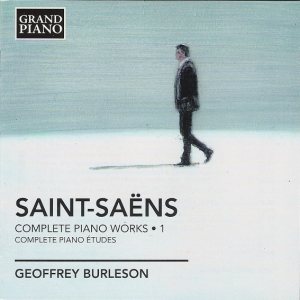 |
 |
|


alternatively
CD: MDT
AmazonUK
AmazonUS
Sound
Samples & Downloads |
Camille SAINT-SAËNS
(1835-1921)
Six Etudes for Piano, Op. 52 [27:01]
Six Etudes for Piano, Op. 111 [21:16]
Six Etudes for the Left Hand Alone, Op. 135 [18:57]
 Geoffrey Burleson (piano)
Geoffrey Burleson (piano)
rec. January-February 2011, Patrych Sound Studios, Bronx, New York,
USA
 GRAND PIANO GP601 [67:14]
GRAND PIANO GP601 [67:14]
|
|
|
It seems weird to say that Camille Saint-Saëns is terribly
underrated as a composer. After all, his Carnival of the
Animals and Organ Symphony are universal mega-hits,
but those two works are part of the problem. Along with the
second piano concerto, they pigeonhole him as a few-hit wonder,
when in fact his craftsmanship and melodic gift made nearly
everything he did important or at least totally enjoyable. As
you might suspect based on the five superb piano concertos,
that extends to his solo piano music.
This, the first volume in a series of the complete piano works,
concerns itself with the composer’s three sets of etudes
(see review of Volume
2). The booklet notes, by pianist Geoffrey Burleson, illustrate
Saint-Saëns’ keyboard virtuosity in surprising detail:
Liszt considered him the greatest organist on the planet, this
after a childhood in which the composer, at the age of 10, “announced
to [an] audience that he would be pleased to perform any of
Beethoven’s 32 sonatas as an encore.” No surprise,
then, that the mature Saint-Saëns would concern himself
with technical studies for the piano, one of the three sets
for left hand alone, nor that he would make these etudes musically
valuable too.
Highlights include the etude op 52 no 6, “en forme
de valse,” a favorite encore of Cziffra’s; op
111 no 6, a dazzling and surprisingly jazzy (in 1899!) toccata
based on the finale of the ‘Egyptian’ piano concerto;
and op 52 no 2, “pour l’indépendance des
doigts,” a melancholy miniature in which the melody
is formed out of numerous repeated chords, which the pianist
stresses differently every time to highlight specific notes.
The result is a spellbinding feat of writing, so simple but
so emotionally compelling in its sadness. There are tributes
to Chopin (the op 111 set opens with a direct quote from his
etudes) and the baroque (there are three preludes and fugues).
The left-hand set Op 135 dates from 1912 and is based on the
dance suites of Rameau and Couperin, with fresh, charming results.
It is not a total precursor to the neoclassical movement, though;
a heartfelt but maybe slightly too long elegy makes sure of
that.
As a performer, Geoffrey Burleson is perfectly competent but
by no means great. This CD duplicates a program offered by Piers
Lane on Hyperion (Lane adds an encore), and side-by-side comparison
reveals Lane’s superiority time and again. It’s
not superiority of virtuosity, per se; compare that sad little
marvel, op 52 no 2: yes, Lane gets through it more quickly,
but he also moves with a lighter touch, a feather-light delicacy
which makes the piece all the more affecting. In many places
Burleson’s phrasing is distinctly plain. I think part
of the problem may be that Burleson’s piano is very closely
miked: it gives a clear, bold picture of the piano’s sound,
but it may be too close to show Burleson’s true ability
in the quietest, softest passages.
This is part of the first wave of releases from the new Grand
Piano record label. Part of the Naxos family, Grand Piano will
be dedicated to premium-quality releases of rare piano music.
The production is impressive: every release this year will feature
stylish cover paintings by Gro Thorsen, and the excellent booklet
essay is in English and French (and a larger typeface than you’ll
find on a Naxos CD). Plans for the label are ambitious: there
will be complete recordings of the piano music of Schulhoff,
Raff, Weinberg (review),
and Tcherepnin (review).
I can’t help wondering if we’ll see Konstantin Scherbakov
tackle Medtner, too. It’s a noteworthy enterprise and
every release so far (there have already been about a dozen)
merits attention. I’ll be following the Weinberg and Tcherepnin
series with special interest, since the first volumes of each
has been outstanding; I had hoped this Saint-Saëns project
would deserve great admiration too, but I find myself liking
the music despite rather humdrum performances. Burleson has
his moments, and he’s written an excellent accompanying
essay, but compared to other recordings this is not a total
success.
Brian Reinhart
|
|

